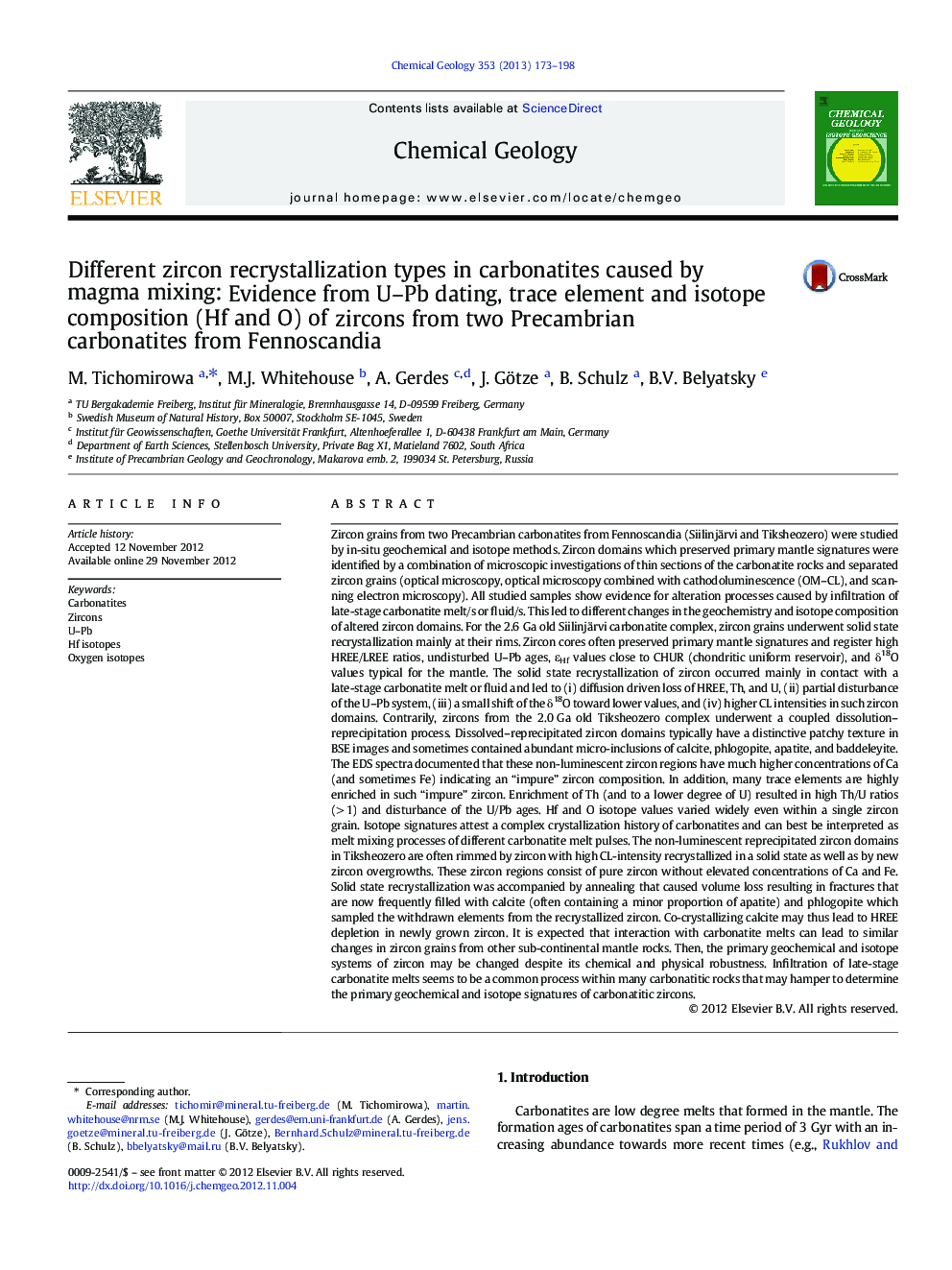| کد مقاله | کد نشریه | سال انتشار | مقاله انگلیسی | نسخه تمام متن |
|---|---|---|---|---|
| 4698938 | 1637616 | 2013 | 26 صفحه PDF | دانلود رایگان |

Zircon grains from two Precambrian carbonatites from Fennoscandia (Siilinjärvi and Tiksheozero) were studied by in-situ geochemical and isotope methods. Zircon domains which preserved primary mantle signatures were identified by a combination of microscopic investigations of thin sections of the carbonatite rocks and separated zircon grains (optical microscopy, optical microscopy combined with cathodoluminescence (OM–CL), and scanning electron microscopy). All studied samples show evidence for alteration processes caused by infiltration of late-stage carbonatite melt/s or fluid/s. This led to different changes in the geochemistry and isotope composition of altered zircon domains. For the 2.6 Ga old Siilinjärvi carbonatite complex, zircon grains underwent solid state recrystallization mainly at their rims. Zircon cores often preserved primary mantle signatures and register high HREE/LREE ratios, undisturbed U–Pb ages, εHf values close to CHUR (chondritic uniform reservoir), and δ18O values typical for the mantle. The solid state recrystallization of zircon occurred mainly in contact with a late-stage carbonatite melt or fluid and led to (i) diffusion driven loss of HREE, Th, and U, (ii) partial disturbance of the U–Pb system, (iii) a small shift of the δ18O toward lower values, and (iv) higher CL intensities in such zircon domains. Contrarily, zircons from the 2.0 Ga old Tiksheozero complex underwent a coupled dissolution–reprecipitation process. Dissolved–reprecipitated zircon domains typically have a distinctive patchy texture in BSE images and sometimes contained abundant micro-inclusions of calcite, phlogopite, apatite, and baddeleyite. The EDS spectra documented that these non-luminescent zircon regions have much higher concentrations of Ca (and sometimes Fe) indicating an “impure” zircon composition. In addition, many trace elements are highly enriched in such “impure” zircon. Enrichment of Th (and to a lower degree of U) resulted in high Th/U ratios (> 1) and disturbance of the U/Pb ages. Hf and O isotope values varied widely even within a single zircon grain. Isotope signatures attest a complex crystallization history of carbonatites and can best be interpreted as melt mixing processes of different carbonatite melt pulses. The non-luminescent reprecipitated zircon domains in Tiksheozero are often rimmed by zircon with high CL-intensity recrystallized in a solid state as well as by new zircon overgrowths. These zircon regions consist of pure zircon without elevated concentrations of Ca and Fe. Solid state recrystallization was accompanied by annealing that caused volume loss resulting in fractures that are now frequently filled with calcite (often containing a minor proportion of apatite) and phlogopite which sampled the withdrawn elements from the recrystallized zircon. Co-crystallizing calcite may thus lead to HREE depletion in newly grown zircon. It is expected that interaction with carbonatite melts can lead to similar changes in zircon grains from other sub-continental mantle rocks. Then, the primary geochemical and isotope systems of zircon may be changed despite its chemical and physical robustness. Infiltration of late-stage carbonatite melts seems to be a common process within many carbonatitic rocks that may hamper to determine the primary geochemical and isotope signatures of carbonatitic zircons.
► Zircon grains in carbonatites underwent recrystallization caused by magma mixing.
► Two recrystallization types: solid state and dissolution–reprecipitation
► Solid state recrystallization causes diffusion driven loss of U, Th, and REE but undisturbed isotope systems.
► Dissolution–reprecipitation: large disturbance in U–Pb system, large variations in trace elements and O and Hf isotopes
Journal: Chemical Geology - Volume 353, 30 August 2013, Pages 173–198